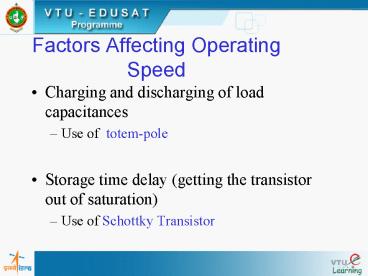Factors Affecting Operating Speed - PowerPoint PPT Presentation
1 / 36
Title:
Factors Affecting Operating Speed
Description:
Basic MOSFET Construction. Basic Structure. Source (S) Gate (G) Drain (D) ... Vo. V2. V1. Summary. MOSFETs. N-channel Enhancement Type. N-channel Depletion type ... – PowerPoint PPT presentation
Number of Views:93
Avg rating:3.0/5.0
Title: Factors Affecting Operating Speed
1
Factors Affecting Operating Speed
- Charging and discharging of load capacitances
- Use of totem-pole
- Storage time delay (getting the transistor out of
saturation) - Use of Schottky Transistor
2
Schottky TTL Diode
- Metal to n-type semiconductor diodes.
- Involves only the flow of majority carriers.
Anode (metal)
Cathode n-type semiconductor
3
Schottky TTL
- A schottky diode placed between the base and
collector of an npn BJT results in a schottky
transistor.
Circuit Configuration
Schottky Transistor symbo l
4
Types of Schottky TTL
- (LS)TTL Low Power Schottky TTL
- (AS)TTL Advanced Schottky TTL
- (ALS)TTL Advanced Low Power Schottky TTL
5
Summary (session 2)
- TTL Logic Family
- Basic TTL NAND Gate
- Wired Logic
- Standard TTL
- Open Collector (to decrease power dissipation)
- Totem-pole (to increase switching speed)
- Wired Totem-pole (not possible)
6
Summary (session 2)
- Variations in TTL
- Three State TTL (with enable input)
- Schottky TTL (to decrease storage time delay)
7
Session 3
- Introduction to MOSFET
- (Basic structure,states,formation of an
n-channel) - N -Channel Enhancement Type MOSFET
- N-channel Depletion Type MOSFET
- P-channel MOSFETs
- MOSFET As a Register
8
Session 3 contd
- NMOS And PMOS Logic Gates
- CMOS Logic Gates
- NOT gate
- NOR gate
- NAND gate
9
FET
- FET is a Field Effect Transistor.
- Only one type of charge carrier flows through the
semiconductor material. - They are also called Unipolar Transistors.
10
Types of FET
- JFET Junction field effect transistor
- commonly used for linear or analog circuits.
- MOSFET Metal Oxide Semiconductor
Field Effect transistor - Commonly used for logic circuit design.
11
MOSFET Properties
- Advantages
- compact and simple to fabricate
- Can be used to realise a resistor(high values)
- Low power dissipation
- Disadvantage
- slower in switching compared to TTL.
12
Basic MOSFET Construction
13
Basic Structure
N-channel Enhancement Type
Metal
Oxide layer (SiO2)
14
Important MOSFET Parameters
- Maximum Drain-Source Voltage ( VDS)
- VDS is the maximum instantaneous operating
voltage. - Continuous Drain Current (ID)
- ID is the maximum current the MOSFET can carry
sometimes specified at a particular junction
temperature. - Maximum Gate-Source Voltage VGS
- VGS is the maximum voltage that can be applied
between gate and source without damaging the gate
insulation. - Gate Threshold Voltage, VT
- VT is the minimum gate voltage at which the
transistor will turn ON
15
OFF State of MOSFET
- Source-Substrate pn junction is zero biased.
- Drain-Substrate pn junction is reverse biased.
- No current flows between source and drain.
- Transistor is said to be OFF
16
Formation Of N-channel
- As VGS is increased, electric field is created
between S and G. Electrons are attracted towards
the ve gate terminal. - When VGSVT, a channel is formed, ID flows and
transistor is ON .
17
ID-VDS Characteristics with VGS constant
- With VGSconst the graph for different values of
VDS (large values) is as given in figure.
18
N-channel Before Pinch Off
- Keeping VGS const and increasing VDS has the
effect that the channel width starts decreasing
at the drain.
19
N-channel At Pinch Off
- The process continues till the channel width
becomes zero at the drain . This condition is
called pinch -off
20
N-channel After Pinch Off
- After pinch off ID is not significantly
dependent upon VDS.
21
N-channel Depletion Type MOSFET
- A lightly doped n-channel is placed between two
heavily doped n-regions(n). - When VGS 0 , the transistor is ON
Lightly doped n-channel
22
Formation Of N-channel
- When VGS is ve the channel depletes.
- At some VGSgt - VT drain and source terminals are
disconnected and transistor is OFF.
23
MOSFET Symbols
a)n-channel enhancement type b)p-channel
enhancement type c)n-channel depletion type
d)p-channel depletion type
24
Enhancement Type MOSFET as Register
- Gate and Drain terminals are connected.
- VDSVGS
25
P-Channel Depletion Type MOSFET as Register
- Channel already exists at VGS0
- Gate is connected to Source.
Resistance is directly proportional to channel
length and inversely proportional to channel
width.
26
NMOS NOT Gate
- Q2 acts as load register.
- Q2 is always on.
- Resistance of Q2(on)gtQ1(on)
27
NMOS NOR Gate
28
NMOS NAND Gate
29
PMOS NOT Gate
- A negative voltage at gate terminal (enhancement
type p-channel)is needed to form a channel. - Positive logic
- Logic 0 -Vddlt-Vt
- Logic 1 0V (gnd)
30
PMOS NOR Gate
31
PMOS NAND Gate
32
CMOS NOT Gate
33
2 Input CMOS NOR Gate
34
2 Input CMOS NAND Gate
35
Summary
- MOSFETs
- N-channel Enhancement Type
- N-channel Depletion type
- Logic Gates With MOSFETs
- PMOS, NMOS, CMOS Networks
- NOT, NOR, NAND Logic
36
MOSFET Fan-Out Effect ON Speed































